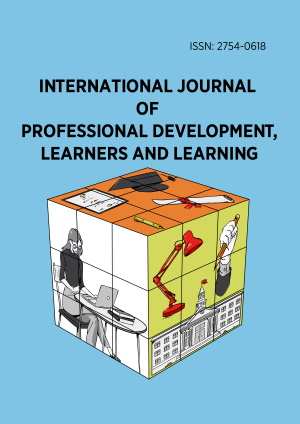Research Article
Methodological guide for the creation of educational materials based on patterns of needs and design
More Detail
1 Universidad Nacional, Heredia, COSTA RICA* Corresponding Author
International Journal of Professional Development, Learners and Learning, 5(2), July 2023, ep2313, https://doi.org/10.30935/ijpdll/13686
Submitted: 03 March 2023, Published: 14 September 2023
OPEN ACCESS 7970 Views 3139 Downloads
ABSTRACT
Teachers face different roles according to the educational needs a student population may require. One of these roles has to do with the teachers´ relationship with the design of educational materials. This paper aims to provide an introductory methodological guide for the creation of educational materials, based on specific patterns of needs and design. It is expected that teachers can also perceive their teaching role as an effective teacher-designer considering four components: needs analysis (NA), instructional design (ID), universal design for learning (UDL), and graphic design (GD). NA is fundamental in the process of creating educational materials to developing actions such as needs inquiry and analysis, allowing the teacher-designer to reflect on the educational material. The use of an ID model provides strong support in the construction of educational materials and allows teacher-designers to generate coherent products that meet the real needs of the student population. The principles of UDL help to make the design of educational resources accessible to the target population. GD goes from being an aesthetic component to making pedagogical contributions, by enhancing the final quality of the material in terms of imagery, color palette, and selected typography. Lastly, educational materials should not lose their main purpose. In this sense, a teacher-designer has to follow patterns of needs and design that can address how particular individuals learn and what they specifically require so a material becomes a functional and successful contribution for the learning process.
CITATION (APA)
Saborío-Taylor, S., & Rojas Ramírez, F. (2023). Methodological guide for the creation of educational materials based on patterns of needs and design. International Journal of Professional Development, Learners and Learning, 5(2), ep2313. https://doi.org/10.30935/ijpdll/13686
REFERENCES
- Alghazo, S. (2016). The role of curriculum design and teaching materials in pronunciation learning. Research in Language, 13(3), 316-333. https://doi.org/10.1515/rela-2015-0028
- Ambrose, G., & Harris, P. (2009). The fundamentals of graphic design. Academia.
- Areekkuzhiyil, S. (2022). Universal design for learning. Edutracks, 21(4), 19-22.
- Augusto-Navarro, E. H. (2015). The design of teaching materials as a tool in EFL teacher education: Experiences of a Brazilian teacher education program. Ilha do Desterro: A Journal of English Language, Literatures in English and Cultural Studies, 68(1),121-137. https://doi.org/10.5007/2175-8026.2015v68n1p121
- Bajracharya, J. (2020). Instructional design and models: ASSURE and Kemp. Journal of Education and Research, 9(2), 1-8. https://doi.org/10.3126/jer.v9i2.30459
- Barghamadi, M. (2020). A critical study of the principles and approaches to needs analysis. Studies in Educational Management, 2020(7), 1-16. https://doi.org/10.32038/sem.2020.07.01
- Cabero, J., & García, C. J. (2017). El diseño instruccional inverso para un recurso educativo abierto en la formación profesional Española: El caso de web apps project [Inverse instructional design for an open educational resource in Spanish vocational training: The case of the web apps project]. Education in the Knowledge Society, 18(2), 19-32. https://doi.org/10.14201/eks20171821932
- CAST. (2018). Universal design for learning guidelines version 2.2. Center for Applied Special Technology. http://udlguidelines.cast.org
- Chen, N., Dai, Y., Fan, X., & Pang, Y. (2022). On the diversified practice of teachers’ roles with the goal of stimulating students’ internal motivation [Paper presentation]. The 2021 International Conference on Education, Language and Art. https://doi.org/10.2991/assehr.k.220131.183
- Elsaid, A. S., & Nur, H. S. M. (2018). Needs analysis in English for academic purposes: The case of teaching assistants at the University of Khartoum. HOW, 25(2), 49-68. https://doi.org/10.19183/how.25.2.409
- Hannah, J. (202). An introduction to color theory and color palettes. CareerFoundry. https://careerfoundry.com/en/blog/ui-design/introduction-to-color-theory-and-color-palettes/
- Hannah, J. (2022). What is typography, and why is it important? A beginner’s guide. CareerFoundry. https://careerfoundry.com/en/blog/ui-design/beginners-guide-to-typography/
- Hill, J., & Jordan, L. (2021). Instructional strategies. In J. K. McDonald, & R. E. West (Eds.), Design for learning: Principles, processes, and praxis. EdTech Books.
- Mariono, A., Desiningrum, N., Nuryasana, E., & Mustaji. (2019). The development teaching materials of learning technology based on character building. Research, Society and Development, 8(8), 1-14. https://doi.org/10.33448/rsd-v8i8.1217
- Mohammed, A. (2020). An ASSURE-model instructional design based on active learning strategies and its effect for 1st intermediate student’s higher order thinking skills in teaching sScience textbook. Psihologija, 52(5), 339-349.
- Murchie, K. J., & Diomede, D. (2020). Fundamentals of graphic design–essential tools for effective visual science communication. FACETS 5(1), 409-422. https://doi.org/10.1139/facets-2018-0049
- Samuel, A. (2009). The importance of instructional materials in our schools: An overview. New Era Research Journal of Human, Educational and Sustainable Development, 2, 61-63.
- Trejo, H. (2018). Herramientas tecnológicas para el diseño de materiales visuales en entornos educativos [Technological tools for the design of visual materials in educational environments]. Sincronía [Synchrony], 74, 617-669. https://doi.org/10.32870/sincronia.axxii.n74.30b18
- UNED. (2008). Metáfora pedagógica [Pedagogical metaphor]. https://observatoriotecedu.uned.ac.cr/media/metafora_pedagogica.pdf

 The articles published in this journal are licensed under the CC-BY Creative Commons Attribution International License.
The articles published in this journal are licensed under the CC-BY Creative Commons Attribution International License.